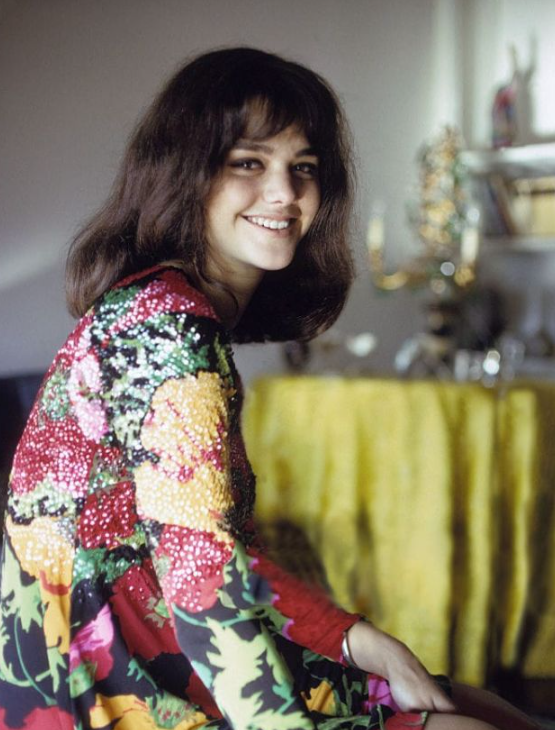Tina Aumont: The 1970s Screen Siren Who Lived Wild and Free
Born into the golden glow of Hollywood royalty, Tina Aumont seemed destined for the spotlight. With her dreamy eyes, untamed beauty, and magnetic charm, she became one of the most captivating faces of 1970s cinema. But Tina wasn’t just another pretty starlet—her life was filled with glamour, rebellion, heartbreak, and resilience that made her story as fascinating as her on-screen roles.

A Star-Studded Beginning: Hollywood Roots
On February 14, 1946, Maria Christina “Tina” Aumont was born in Hollywood, California. Her father was French actor Jean-Pierre Aumont, and her mother was Dominican actress Maria Montez, famously known as the “Queen of Technicolor.” Poets and icons like Jean Cocteau and Marlene Dietrich welcomed her into the world, setting the tone for her extraordinary life.

Tragedy struck early when Tina’s mother died of a heart attack in 1951, leaving her only five years old. Raised between France, America, and Swiss boarding schools, Tina’s childhood was glamorous yet fragmented. By her teens, her striking looks and fiery spirit were undeniable. Her father encouraged her to study acting under Stella Adler in New York, preparing her for a career that would be bold, unconventional, and unforgettable.
Video : La Vida y El Triste Final de Tina Aumont
A Bold Debut: From Modesty Blaise to Italian Stardom
At just 17, Tina shocked many when she married French actor and director Christian Marquand. She debuted in Joseph Losey’s Modesty Blaise (1966), billed as Tina Marquand, where her natural charisma stole scenes. Hollywood noticed, but Italy embraced her.

Moving to Rome, Tina found her true stage in Italian cinema. She starred in films like Scusi, lei è favorevole o contrario? (1966), Texas Across the River (1966) with Dean Martin, and later in Tinto Brass’s The Howl (1970). Her performance in Salon Kitty (1975) cemented her reputation as a daring, sensual actress, while Fellini’s Casanova (1976) proved she could stand alongside legends. Italian directors adored her ability to embody mystery and allure.

The Wild Child of European Cinema
Tina Aumont wasn’t just acting—she was living the free-spirited counterculture of the 1960s and ’70s. She mingled with Mick Jagger, Marlon Brando, and underground artists like Nico, immersing herself in avant-garde circles. Her friendships pulled her into experimental cinema with director Philippe Garrel, where she explored roles that mirrored her bohemian lifestyle.

But fame’s dark side caught her too. After a miscarriage and divorce from Marquand, Tina spiraled into addiction and scandal. In 1978, she was arrested in Italy for smuggling opium hidden in Buddha statues, sentenced to prison, and deported. The headlines painted her as a fallen star, but her resilience remained.

Defining Roles and Fearless Choices
Despite personal struggles, Tina delivered unforgettable performances. In thrillers like Torso (1973), she embodied the raw edge of Italian giallo cinema. In Illustrious Corpses (1975) and Drama of the Rich (1974), she showcased her depth as an actress who could play more than just the seductress.

Her work was fearless. She often accepted roles that others might shy away from—complex, sensual, and layered characters that mirrored her own untamed life. To audiences, Tina Aumont was like fire: bright, unpredictable, and impossible to ignore.
Video : Interview Tina Aumont on Fellini’s Casanova; Intervista Tina Aumont sul Casanova di Fellini
Love, Loss, and a Bohemian Spirit
Tina’s relationships reflected her adventurous spirit. Beyond her short marriage to Marquand, she later married painter Jean-François Ferriol and had romances with figures in the European art scene. She was rarely without a circle of creative, rebellious souls around her.

Yet, behind the glamour, she longed for connection and often spoke of the mother she barely remembered. When she passed in 2006, her ashes were placed beside Maria Montez in Montparnasse Cemetery, symbolizing the bond that transcended her turbulent life.

A Quiet Exit and Lasting Legacy
Tina retired from acting in 2000, retreating into a quieter life. On October 28, 2006, she died at 60 from a pulmonary embolism in Port-Vendres, France. The news saddened fans worldwide who remembered her as one of the boldest and most magnetic actresses of her era.

Her films, now restored and reappraised, continue to capture new audiences. Whether in cult classics like Torso or the art-house depth of Garrel’s projects, Tina’s screen presence endures.

Conclusion: A Star Who Burned Bright
Tina Aumont lived a life as dazzling and unpredictable as her career. Born into Hollywood royalty, she carved her path in Italian cinema, where her beauty, charisma, and wild spirit defined a generation of films. She faced heartbreak, scandal, and personal battles, but her resilience kept her unforgettable.

Tina wasn’t just a 1970s sex symbol—she was a woman who lived passionately, embraced risks, and left behind a cinematic legacy that still glows. Her story is one of beauty, rebellion, and a reminder that the brightest stars are often the most untamed.